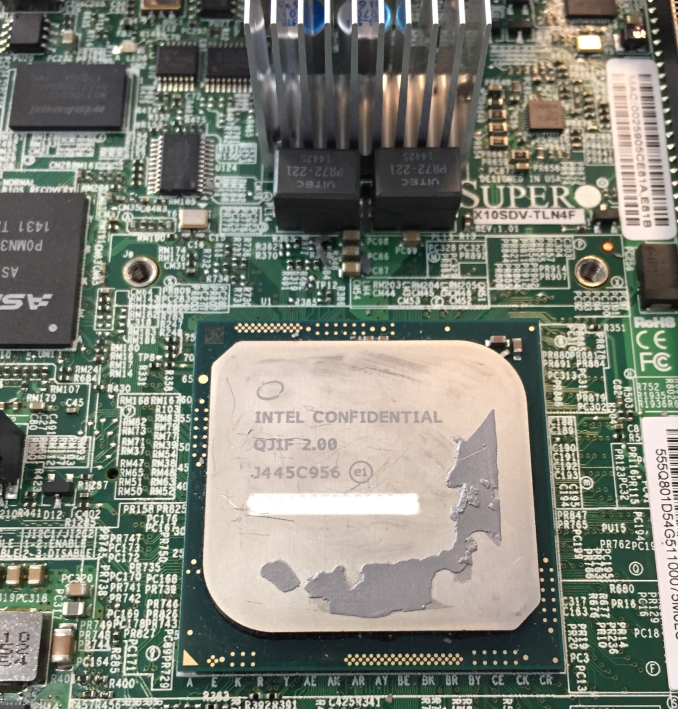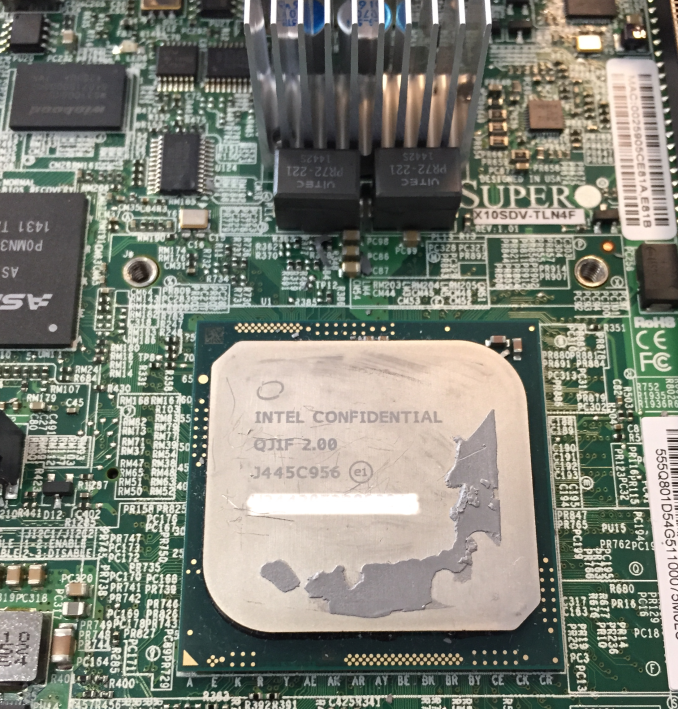The Intel Xeon D Review: Performance Per Watt Server SoC Champion?
by Johan De Gelas on June 23, 2015 8:35 AM EST- Posted in
- CPUs
- Intel
- Xeon-D
- Broadwell-DE

The days that Intel neglected the low end of the server market are over. The most affordable Xeon used to be the Xeon E3: a desktop CPU with a few server features enabled and with a lot of potential limitations unless you could afford the E5 Xeons. The gap, both in performance and price, between Xeon E3 and E5 is huge. For example - a Xeon E5 can address up to 768 GB and the Xeon E3 up to 32 GB. A Xeon E5 server could contain up to 36 cores, whereas Xeon E3 was limited to a paltry four. And the list is long: most RAS features, virtualization features were missing from the E3, along with a much smaller L3-cache. On those terms, the Xeon E3 simply did not feel very "pro".
Luckily, the customers in the ever expanding hyperscale market (Facebook, Amazon, Google, Rackspace and so on) need Xeons at a very large scale and have been demanding a better chip than the Xeon E3. Just a few months ago, the wait was over: Xeon D fills the gap between the Xeon E3 and the Xeon E5. Combining the most advanced 14 nm Broadwell cores, a dual 10 gigabit interface, a PCIe 3.0 root with 24 lanes, USB and SATA controllers in one integrated SoC, the Xeon D has excellent specs on paper for everyone who does not need the core count of the Xeon E5 servers, but who simply needs 'more' than the Xeon E3.
Many news editors could not resist calling the Xeon D a response to the ARM server threat. After all, ARM has repeated more than once that the ambition is to be competitive in the scale-out server market. The term "micro server" is hard to find on the power point slides these days; the "scale-out" market is a lot cooler, larger and more profitable. But the comments of the Facebook engineers can quickly brings us back to reality:
"Introducing "Yosemite": the first open source modular chassis for high-powered microservers"
"We started experimenting with SoCs about two years ago. At that time, the SoC products on the market were mostly lightweight, focusing on small cores and low power. Most of them were less than 30W. Our first approach was to pack up to 36 SoCs into a 2U enclosure, which could become up to 540 SoCs per rack. But that solution didn't work well because the single-thread performance was too low, resulting in higher latency for our web platform. Based on that experiment, we set our sights on higher-power processors while maintaining the modular SoC approach."
It is pretty simple: the whole "low power simple core" philosophy did not work very well in the real scale out (or "high powered micro server") market. And the reality is that the current SoCs with an ARM ISA do not deliver the necessary per core performance: they are still micro server SoCs, at best competing with the Atom C2750. So currently, there is no ARM SoC competition in the scale out market until something better hits the market for these big players.
Two questions remain: how much better is the 2 GHz Xeon D compared to the >3GHz Xeon E3? And is it an interesting alternative to those that do not need the high end Xeon E5?











90 Comments
View All Comments
AkulaClass - Tuesday, June 23, 2015 - link
Nice stuff. Realy good to see them bringing power consumption down pr. Performance.WorldWithoutMadness - Tuesday, June 23, 2015 - link
Nice way to confuse people. Codename Yosemiteretrospooty - Tuesday, June 23, 2015 - link
Who would this confuse? Apple fans because of the OS witht he same codename?LOL. Believe me they don't know, or care... Most of them aren't even aware of what a "server" chip is, or even what a "server" is used for.
IanHagen - Tuesday, June 23, 2015 - link
Rails developer checking in to remind you that a great chunk of the Rails community develop using OS X to deploy on Linux and hence is aware of "server chips". Even though you said that "most" Apple users don't know what a server chip is and that's accurate, the same could be said about Windows or even Linux common users. Stop patronizing.All being said, I agree with you. Who could possibly confound the Xeon D's codename coincides with OS X's 10.10 name?
WinterCharm - Tuesday, June 23, 2015 - link
First of all, your implication that apple fans don't know jack shit about servers is a broad generalization, and a stupid one at that.Second of all, anyone who knows enough to even consider buying a Xeon and a motherboard that supports it and the ECC memory, probably knows enough to not get confused. And plenty of mac users know what server chips are and what they're used for.
Nice trolling though.
adithyay328 - Tuesday, August 25, 2015 - link
That's not entirely true, but I will agree that people a lot of the people who use Apples( No discrimination intended) only continue to use Apple due to their lack of tech knowledge( like knowing Android is the king :) . And, yes, they probably won;t know what servers even are.jeffsci - Monday, June 29, 2015 - link
Geographic code names are the norm in the computing industry (I think because they cannot be copyrighted) and they end up being reused. For example, Intel Seattle is/was a motherboard and AMD Seattle is/was an ARM64 processor. See https://en.wikipedia.org/wiki/List_of_Intel_codena... https://en.wikipedia.org/wiki/List_of_Microsoft_co... etc. if you would like to look for more examples :-)RaiderJ - Tuesday, June 23, 2015 - link
Any places in the US that the motherboard is available for purchase? Quick checks looks like it's mostly sold out or otherwise unavailable?ats - Tuesday, June 23, 2015 - link
Availability comes and goes. Xeon D has been a big hit in the large scale deployment markets and they've been soaking up a lot of demand for it, both bare and combined on motherboards like the supermicro offerings severely limiting retail availability. But it is available in retail but quantities are limited. Quite a number of people over at servethehome have gotten their hands on them. If you want one, you'll likely have to keep checking the major sites like newegg, amazon, et al for them to come back in stock. Retail boards are generally in the $800-1000 range atm (basically going for full list but then again bare motherboards with 10gbe tend to go for 600+ so its still a good buy and simple new 10gbe cards tend to go for $300-500).ToTTenTranz - Tuesday, June 23, 2015 - link
How come they call this a SoC if there's no integrated module to drive even a simple display, and they apparently need a discrete PCIe graphics card for that D-SUB output?